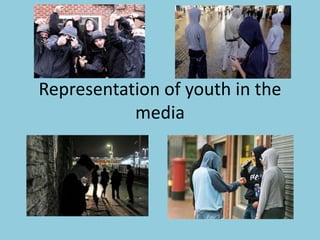
Collective identity youth
- 1. Representation of youth in the media
- 2. QUESTIONS WE WILL ANSWER IN TODAY’S LESSON: • How is youth represented in the media? • How does media language work to create meaning? • How are some representations stereotyped and stylized?
- 3. MORAL PANIC
- 4. Moral Panic A condition, episode, person or group of persons emerges to become defined as a threat to societal values and interests; its nature is presented in a stylized and stereotypical fashion by the mass media Stanley Cohen (1972)
- 5. Cohen’s Moral Panic Study of the representation of mods and rockers from the 1960s http://www.youtube.com/watch?v=r61ks18B d7I#t=45
- 6. Although Cohen points to the ways in which the media amplify anxieties and events and create a moral panic, the demonization of youth in this way can only come about if there is some kind of collective identity to which to point. In this case a ‘mod’ and a ‘rocker’. Two different identities formed through a collective wearing certain clothes and listening to certain types of music. Rockers: rode motorcycles, wore black leather and listened to rock ‘n’ roll Mods: rode scooters, wore suites and listened to south, rhythm and blues, and ska Sdgs Sgsggssg Sgsggsgsg Sghshfhsdfhsd sfhshsh
- 7. You can also see how certain subcultures of youth were demonized in the 1980s; The punk era
- 8. The Mob’s Brief Rule
- 9. Representation • Everything you see or hear in ALL types of media has been carefully SELECTED and CONSTRUCTED in order to create meaning •Media representations often reflect the dominant ideologies of the society in which they are created
- 10. How is moral panic created in the media?
- 15. “HOODIES AND ALTAR BOYS” The word most commonly used by newspapers to describe teenage boys was "yobs" (591 times), followed by "thugs" (254 times), "sick" (119 times) and "feral" (96 times). Other terms often used included "hoodie", "louts", "heartless", "evil" "frightening", "scum", "monsters", "inhuman“ and "threatening". Research showed the best chance a teenager had of receiving sympathetic coverage was if they died.
- 17. What are the wider social implications?
- 18. Question: Who makes these media representations of youth? Can this ever be a fair portrayal?
- 19. Let’s look specifically urban youth culture • What do these people wear? • What music do they listen to? • What do they do in their spare time? • Where do they live? • Any other character traits/ appearance?
- 20. What is meant by stylized and stereotyped representations ?
- 21. Top Boy (2011)
- 22. Camera Angles/ Shots: High Camera Angle Low Camera Angle Hand Held Camera Point of View Long Shot Mid Shot Close-Up Extreme Close-Up Tracking Shot Pan Tilt Editing: Shot/Reverse Shot Cross Cutting Cut Away Eye Line Match Sound: Diegetic Sound (in the world of the film)- dialogue, ambient sounds, etc. Non-Diegetic Sound (not in the world of the film)- Soundtrack, voice over, etc. Mise-en-Scene: Everything that is on the screen- Location Props Clothing Media Language TECHNICAL CODES AUDIO CODES SYMBOLIC CODES
- 23. Questions to consider • How is youth represented in this sequence? • How do technical codes, audio codes and symbolic codes work to create meaning? • Can you apply Cohen’s theory that representations are stylized and stereotyped (through media language)?
- 25. Going from the Macro to the Micro How to structure your answer Historical context- how has youth been represented in the past? In this case through newspapers and news broadcasts. Apply Cohen’s theory of moral panic Contemporary examples- how is youth represented now? In this case through newspapers (the student riots) and TV (Top Boy). Can you apply Cohen’s theory? What about other theorists you have looked at? Barthes, Gauntlett, etc? What are the wider social implications (the macro) How are representations stylized and stereotyped? Engage in a detailed examination of Top Boy (the micro) How is identity formed? How might different groups of people interpret these representations? The future?- what is the future for representation of youth in the media? Do dominant representations inform identity?
- 26. Analyse the way in which the media represent one group of people that you have studied. [50 marks]